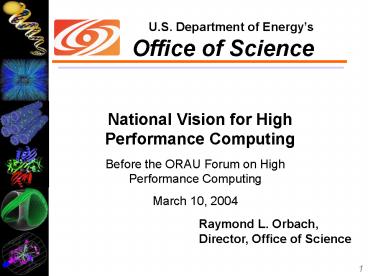National Vision for High Performance Computing - PowerPoint PPT Presentation
Title:
National Vision for High Performance Computing
Description:
National Vision for High Performance Computing Before the ORAU Forum on High Performance Computing March 10, 2004 Raymond L. Orbach, Director, Office of Science – PowerPoint PPT presentation
Number of Views:43
Avg rating:3.0/5.0
Title: National Vision for High Performance Computing
1
National Vision for High Performance Computing
Before the ORAU Forum on High Performance
Computing March 10, 2004
Raymond L. Orbach, Director, Office of Science
2
- This revolution is caused by two developments
one is the set of instruments such as electron
microscopy, synchrotron x-ray sources, lasers,
scanning microscopy, and nuclear magnetic
resonance devices the other is the availability
of powerful computing and information
technology. Together these have brought science
finally within reach of a new frontier, the
frontier of complexity. - --Presidents Science Advisor Jack Marburger
before the AAAS in February, 2002 - In science of the 21st century, simulation and
high-end computation are equal partners with
theory and experiment. - Scientific leadership, the basis for our
economic, physical, and intellectual prosperity
depends on this triad, our being first in each
component. - --Dr. Raymond L. Orbach before the Rand Graduate
School, June 22, 2002
3
- The science of the future demands that we
advance beyond our current computational
abilities. Accordingly, we must address the
following questions - What new mathematics are required to effectively
model systems such as the Earths climate or the
behavior of living cells that involve processes
taking place on vastly different time and/or
length scales? - Which computational architectures and platforms
will deliver the most benefit for the science of
today and the science of the future? - What advances in computer science and algorithms
are needed to increase the efficiency with which
supercomputers solve problems for the Office of
Science? - What operating systems, data management,
analysis, model development, and other tools are
required to make effective use of
future-generation supercomputers? - Can we develop a new sociology to fully utilize
high-end computational power?
4
WHAT IS THE OFFICE OF SCIENCE DOING? The Office
of Science is working to build leadership class
machines that will exceed 50 sustained teraflops
to begin to simulate and understand the
fundamental physical, chemical and biological
processes of natural and manmade systems. To
meet the need for effective computing performance
in the 100-teraflop range and beyond, the Office
of Science will support the evaluation,
installation, and application of new very
high-end computing architectures for
computational science. These high-performance
computers will provide a new window for
researchers to observe the natural world at a
fidelity that could only be imagined a few years
ago.
5
WHAT HAPPENS AT 50 TFLOPS SUSTAINED SPEED?
6
INCITE
10 of NERSC capability made available to the
scientific community for high impact science. No
requirement for direct relationship to Office of
Science programs. INCITE will encourage the
development of a new sociology for high-end
computation.
- 4,500,000 CPU hours available (10 of NERSC
Capability) - 53 proposals received
- 130,508,660 CPU hours requested
- 65 from U.S. academic institutions
- 12 different scientific disciplines
- 62 for research not funded by DOE
- Three Awards
- Thermonuclear Supernovae Stellar Explosions in
Three Dimensions, Tomasz Plewa, Center for
Astrophysical Thermonuclear Flashes, University
of Chicago (2.7 million processor hours). - Fluid Turbulence and Mixing at High Reynolds
Number, Professor P. K. Yeung, Georgia
Institute of Technology (1.2 million processor
hours). - Quantum Monte Carlo Study of Photoprotection via
Carotenoids in Photosynthetic Centers, William
A. Lester, Jr., Lawrence Berkeley National
Laboratory and the University of California
Berkeley ( 1 million processor hours).
7
NGA COMPETITION
On February 23, 2004 the Office of Advanced
Scientific Computing Research (ASCR) of the
Office of Science (SC), U.S. Department of Energy
(DOE) announced its interest in receiving
applications for leadership-class scientific
computing capability in support of both the ASCR
and the broader SC research programs as well as
other capability-limited federally-funded
computational science activities.
- 25 Million available for single award in FY
2004 with an additional 25 million in the
Presidents FY 2005 budget request - Proposals Due April 2, 2004
- Award announced on or about April 15, 2004
8
THE PATH FORWARD
A multi-agency High-End Computing Revitalization
Task Force organized by the Office of Science and
Technology Policy is developing a roadmap to
revitalize U.S. supercomputing. Its report is
due to the Presidents Science Advisor
shortly. We have strengthened our partnerships
with the Defense Advanced Research Projects
Agency and the National Nuclear Security Agency
through a Memorandum of Understanding to ensure
the best evaluation of the effectiveness of
existing and future architectures for various
types of scientific problems. The Office of
Science will work to determine potential effects
of advances in high end computing. In
particular, we will address What are
scientific needs and priorities for high
performance computing? How well do these
requirements match existing and future system
architectures ? What are the opportunities for
expanded HPC applications? What are the
drivers or constraints to expanded HPC usage?































